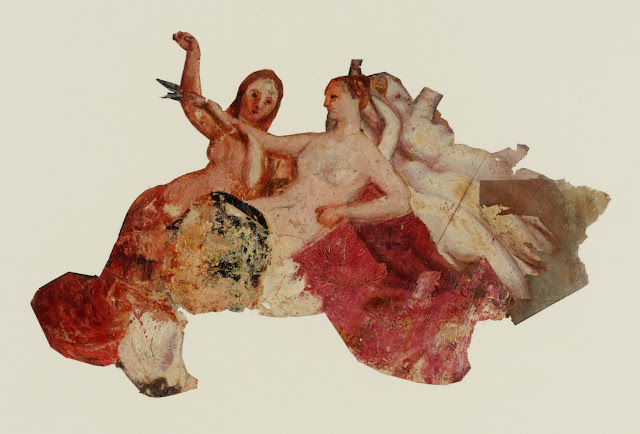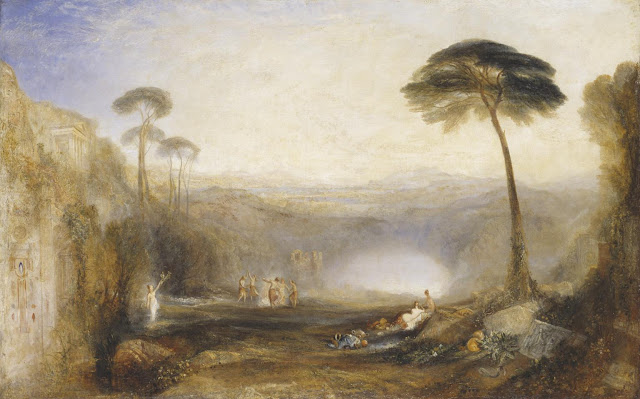 |
| Abraham Kent Right hand and arm of Victoria, Princess Royal 1843 marble Royal Collection, Great Britain |
"Following Queen Victoria's death in 1901 a collection of fourteen marble hands and feet, facsimiles of the infant limbs of her children, was sent from her private apartments at Buckingham Palace to be kept at Osborne. These remarkable objects were presented on crimson velvet cushions (in some cases marble slabs) and kept under glass domes to preserve the pristine whiteness of the marble. They are another manifestation of the Queen's desire to capture fleeting likenesses and souvenirs of her children as they grew, whether by means of miniature portraits or jewellery fashioned out of milk teeth. Although hands and feet are often the features that mothers remember of their babies, and firms exist even today to offer casts, Queen Victoria seems to have favoured marble replicas as providing the most faithful souvenirs. The need to realise the limbs in marble is perhaps best explained by a passage in Balzac's Le Chef-d'oeuvre inconnu in which an elderly painter, Frenhofer, lectures the young Frans Pourbus: the mission of art, he declares, is not to copy nature but to explain it. A plaster cast of the hand of one's mistress seems like 'a horrible cadaver, without the slightest resemblance'; it requires 'the chisel of a man who, without copying it exactly, can impart to it movement and life'. Owing to the subconscious funerary association of white marble, many visitors to Osborne mistake the limbs for memorials of children who died in infancy, whereas all of Queen Victoria's nine children survived well into adulthood."
– Jonathan Marsden, from Victoria & Albert: Art & Love (Royal Collection Trust, 2010)
 |
| William Blake Christ Appearing to the Apostles after the Resurrection ca. 1795 watercolor Tate Gallery |
"In the final chapter of St. Luke's gospel, two angels announce that Christ has risen from the tomb. Later, Christ himself appears to his disciples. As Blake shows here, they are terrified, thinking that they are seeing a ghost. Christ tries to reassure them by holding out his hands to show the wounds he received at the crucifixion, and saying 'Behold my hands and my feet, that it is I myself: handle me, and see; for a spirit hath not flesh and bones, as ye see me have.'"
– curator's notes from the Tate Gallery
 |
| Joseph Mallord William Turner Group of partly-draped female figures, possibly the Fates from Turner's painting The Golden Bough ca. 1834 oil on paper Tate Gallery |
"This unusual survival is in oils on what Finberg described as 'tracing paper' – it shows a carefully finished group of reclining women, among and partly covered by red and black draperies, trimmed to the edges of the figures. Two on the left raise their arms in graceful gestures; the grouping to the right is less legible, with at least three reclining nudes, two of whom face each other while a third looks up to the right, again gesturing with her arm, albeit in this case truncated above the elbow. Although close examination suggests five figures, the third and fourth are relatively inconspicuous, and John Gage has proposed that the group represents 'the Three Fates', which had been 'apparently drawn in a sketchbook in the life class of the Academy, cut out, and glued on the canvas' of Turner's mythological painting The Golden Bough [directly below], which he exhibited at the Royal Academy in 1834. This would account for the anecdote recounted by Gage, that when the painting was subsequently owned by Robert Vernon 'this paper began to peel, and the artist was called in to make a repair. He removed the paper and kept it, repainting the group on the canvas . . . with only two figures facing away . . . and with no attributes to identify them'."
– Tate Gallery, catalogue text by Matthew Imms (2016)
 |
| Joseph Mallord William Turner The Golden Bough ca. 1834 oil on canvas Tate Gallery |
 |
| Joseph Mallord William Turner Group of partly draped female figures, perhaps the Three Graces ca. 1830-40 oil on paper Tate Gallery |
"The subject of this unusual small-scale oil painting on 'tracing paper' is unclear, as is its purpose. It was possibly used to try out a grouping of figures for a larger painting in process. Compare Tate D36262 [the cut-out above], another small painting on paper of a group of elegant nudes; it has been proposed that the latter actually spent some years pasted onto a finished painting of The Golden Bough, exhibited at the Royal Academy in 1834."
– Tate Gallery, catalogue text by Matthew Imms (2016)
 |
| Frederic, Lord Leighton Head of Fanny Kemble - study for Jezebel and Ahab ca. 1862 drawing Tate Gallery |
"Leighton was the most eminent of all artists working during Queen Victoria's reign. He trained in Germany and Paris. One result of this training was the importance he attached to making preliminary drawings for any composition he painted in oils. This drawing is a study for head of Elijah in Leighton's 1863 Royal Academy exhibit Jezebel and Ahab which is now in Scarborough Art Gallery. The model was Leighton's friend the actress Fanny Kemble. The use of a woman to pose for a male figure seems unusual, but the drawing would have been used by Leighton to set a male model when he stood for the figure of Elijah for the painting."
– curator's notes from the Tate Gallery
 |
| William Blake The Simoniac Pope ca. 1824-27 watercolor Tate Gallery |
"In Hell, Dante and Virgil meet those guilty of simony (buying or selling ecclesiastical preferment). Like all simoniacs, Pope Nicholas III is punished by being suspended head downward in a well of fire."
– curator's notes from the Tate Gallery
 |
| Tom Phillip Canto XXVIII from Dante's Inferno 1983 screenprint Tate Gallery |
 |
| attributed to George Richmond Fettered Nude Figure reclining by a Rock ca. 1825 drawing Tate Gallery |
 |
| John Hamilton Mortimer Monstrous Male Figure, possibly Caliban 1770s drawing Tate Gallery |
 |
| Edward Burne-Jones Study for painting, The Call of Perseus ca. 1877 drawing Tate Gallery |
 |
| James Barry Study for painting, Philoctetes on the Island of Lemnos 1770 drawing Tate Gallery |
"Philoctetes was a Greek hero, celebrated for his stoic endurance of suffering. A festering wound on his foot meant that he was left behind on the island of Lemnos while the Greek army continued its journey to Troy. Barry based Philoctetes's body on a celebrated fragment of classical sculpture, the Belvedere Torso. But his notes in the corner of the drawing show a major problem facing history painters: how to suggest bodily pain without resorting to distortions of the face which would destroy the dignity of a heroic figure."
– curator's notes from the Tate Gallery
 |
| William Orpen Anatomical Study, Male Torso ca. 1906 drawing Tate Gallery |
 |
| James Thornhill Sketch for Invitation Card to The Feast of St Luke for The Virtuosi of St Luke 1714 drawing Tate Gallery |
"James Thornhill was an eminent figure in the London art world. In 1714 he replaced Kneller as the Governor of the Great Queen Street Artists' Academy. Shortly after, he was made a member of the the Virtuosi of St. Luke, the most prestigious art club. In 1714 Thornhill hosted the club's annual feast at his house in the Piazza, Covent Garden. The ink sketch is a preliminary design for the invitation card. A jovial centaur points to a canvas showing St. Luke, patron saint of artists, painting the Virgin and Child. St. Paul's church, Covent Garden, appears in the background."
– curator's notes from the Tate Gallery